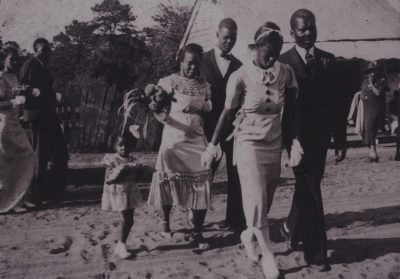Listening to witnesses: The evolving history of Hobcaw Barony
18 May 2017 – Betsy Newman

Minnie Kennedy’s sister Nettie and her groom, Rainey Gardner, on their way to be married at Friendfield Church on Hobcaw Barony sometime in the 1920s. Photographer unknown. Photo credit: Belle W. Baruch Foundation.
For the last five years, South Carolina ETV, the state’s public television network, has been experimenting with ways to tell the story of a 16,000-acre undeveloped property called Hobcaw Barony. Hobcaw, from a Native American word meaning “between the waters,” has a long history of human occupation that stretches from Native American settlement through slavery and Reconstruction to the twentieth century, when it became the winter hunting retreat of financier Bernard Baruch. Even after interpreting several aspects of Hobcaw’s past, we gave new resonance to the site’s history by adding the voices of former African American residents. Our process is a reminder that historical interpretation is an ongoing process. Curators, tour guides, and documentarians should be willing to dig deeper and rethink their interpretive plans based on new discoveries.
Located twenty-five miles south of Myrtle Beach—South Carolina’s most popular coastal resort—Hobcaw offers a bonanza for public historians. Our original emphasis was on the Baruch narrative, which we explored in a documentary for broadcast on SCETV. During production of the television program, we interviewed Minnie Kennedy, a descendant of enslaved African Americans who was born on Hobcaw Barony. Ms. Kennedy allowed us to link Hobcaw’s history to the region’s fraught history of slavery and racial segregation and showed us the value of seeking out “witnesses” when creating public history projects.
We realized it was going to be hard to convey Hobcaw’s multiple stories through the linear medium of television. Having worked in content development for SCETV’s educational web portal Knowitall.org, our team had experience with interactive formats. The idea of a self-guided web documentary began to take shape, using Hobcaw Barony as a local case study of many strands of history. We received funding from the National Endowment for the Humanities, first for a prototype and subsequently for the fully implemented project. The result is the new online exhibit and virtual tour Between the Waters.
Minnie Kennedy was 93 when we met her. Born in 1916, she was delivered by a midwife in a small house that had no electricity or running water, and was once occupied by enslaved people. (She hated calling these dwellings slave cabins. “These were people’s homes!” she insisted.) Her interview was powerful. The stories she told about her family, the relationships between people in Hobcaw’s African American villages, and the paternalistic attitude of the Baruchs toward black workers on the property, turned out to be some of our most valuable original research.
As we continued with production of the website, the interpretive staff at Hobcaw introduced us to Robert McClary and Joshua Shubrick, both of whom, like Minnie Kennedy, had lived on the property as children. In their eighties when we interviewed them, these men shared detailed, painfully honest accounts of growing up poor and black at Hobcaw Barony during the Jim Crow era. Mr. Shubrick showed us his grandfather’s house, where the walls were covered with newspaper for insulation, and croker sacks served as blankets. In 2015, Mr. McClary brought his wife and five daughters to Hobcaw. They toured the one-room schoolhouse he attended in the 1930s, and responded with moving reflections on their father’s education. A video of the family can be found on Between the Waters in the Strawberry School module.
All three of these elders died during the production of Between the Waters. Getting to know them confirmed for us the value of place-based living memory, and we have come to consider their interviews to be the heart of the project. Our witnesses helped us understand that public history involves both making history accessible to the public and involving the public in the production of that history. They also taught us that the public often pushes historians toward a richer, fuller portrait of the past.
~ Betsy Newman is a documentary producer and web content developer at South Carolina ETV and the director of the Between the Waters project.




WHY WERE THERE SO MANY DEATHS???